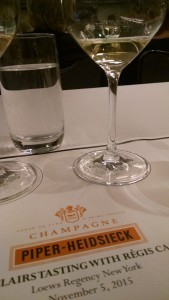 Once upon a time (also known as several years ago), we found a scrap of plastic film that read, “Assembly of Dust. Some Assembly Required.”
Once upon a time (also known as several years ago), we found a scrap of plastic film that read, “Assembly of Dust. Some Assembly Required.”
Not knowing what it was or what is meant, it was one of the strangest and most confusing things we ever found on our kitchen counter. After much scratching of our collective heads, we finally identified the scrap as having come from the wrapper of a music CD that a houseguest had opened earlier that day. (It turns out that Assembly of Dust is the name of a band).
The creation of Champagne is truly like that moment – perplexing and puzzling – with lots of assembly required. In fact, lots is an understatement as evidenced by a recent visit from winemaker Régis Camus of Champagne House, Piper-Heidsieck.
During his trip to New York, Camus offered up a unique glimpse into this creation process, known as assemblage, with a tutored vin clairs tasting. A vin clair is a still wine (not sparkling) that has been produced in anticipation of making the blend that will ultimately be bottled for the secondary fermentation; in essence, each vin clair is the equivalent of a single puzzle piece.
Within the Champagne region, there are hundreds of puzzle pieces to be considered. First, there is grape variety; the permitted grapes include Chardonnay, Pinot Noir and Pinot Meunier. Then, there are the approximately 100 different crus (top vineyards) from which the grapes are sourced. Third is a Champagne House’s Reserve wines – wines saved from previous vintages (and kept distinctly by individual vintage). And finally, there is the time that the wine is aged on its lees as the last piece of the puzzle, which is dictated in part by law (a minimum of 15 months for non-vintage and three years for vintage) and by house style, which typically exceed the minimums.
After each harvest, the winemaker and his team start with a blank canvas as the grapes are brought to the winery. Each parcel is fermented separately into wine, becoming the multitude of puzzle pieces – or vin clairs – available to the team. Their mission, which they choose to accept each year, is to taste through the individual wines and build the puzzle based upon the given vintage.
There is no printed box to follow, instead, the “picture” for these puzzle pieces comes in the shape of a bottle – the bottle of the wine produced the year before (and the year before that…). More specifically, the goal is to replicate the house style for each of the House’s wines. By achieving this goal, consumers can be sure that each and every time they buy a bottle of Piper-Heidsieck Brut NV, it will taste precisely the same.
At Camus’ tasting, we were given five different samples that had been part of the 2014 assemblage for the Piper-Heidsieck Brut NV: Chardonnay Avize Cru 2014, Pinot Noir 2015 Verzy Cru, Pinot Meunier 2014 Ecueil Cru, Chardonnay 2009 Avize Cru and Pinot Noir 2008 Verzy Cru.
As in working to piece together a visual puzzle, each vin clair provides a sought-after characteristic that helps to shape the resulting wine; each piece adding something that would be missing without it. For instance, the Chardonnay 2014 Avize Cru was particularly prized for its structure and tension as well as its freshness, fruit and minerality. Meanwhile, the older Chardonnay provided more pronounced minerality and was richer, giving some needed depth to the final blend.
In all, the 2014 assemblage contained 55% Pinot Noir, 15% Chardonnay and 30% Pinot Meunier, representing approximately 110 different puzzle pieces, inclusive of 10% Reserve wines. It’s enough to make one dizzy (and that’s not accounting for the alcohol). However, the vin clair tasting did offer some insight into this complex process and gave me a renewed respect for these master tasters.
I prefer to leave the assembly to the Chef du Cave and drink the finished product; perhaps it will sustain me as I pour over my next 1,000-piece jigsaw puzzle.
NB: At the conclusion of the formal tasting, we had the opportunity to enjoy several of Piper-Heidsieck’s Champagnes along with passed canapés. Given the informal format, I didn’t take tasting notes, but I was especially fond of the Rosé Sauvage and the prestige cuvée, Rare Millésime 2002. I may even have been willing to pose with the latter bottle’s laser cut label worn as a tiara.
